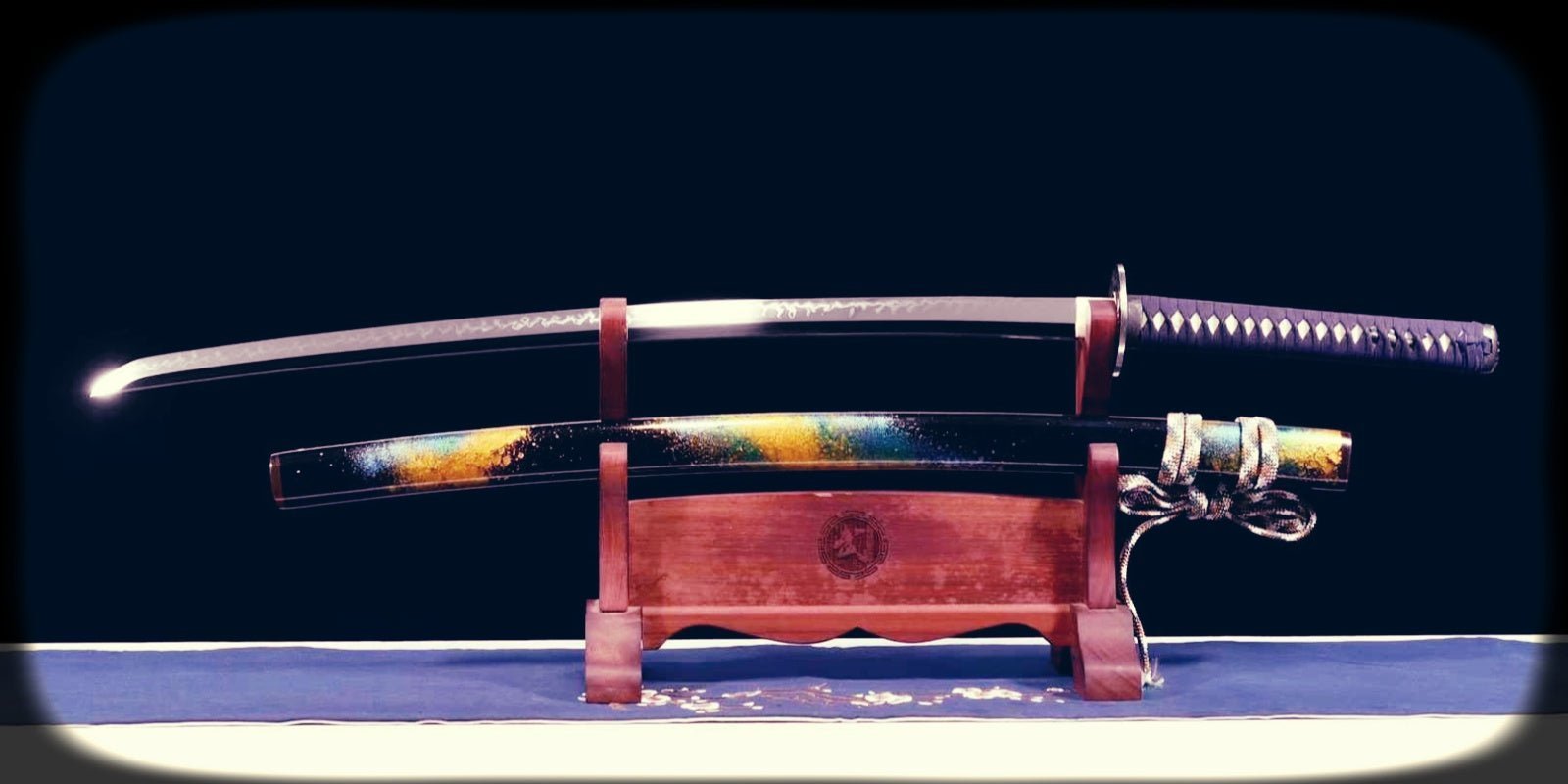Introduction: The Timeless Craft of the Samurai Sword
The samurai sword, or katana, represents a profound intersection of art, history, and functionality that spans centuries. Renowned for its exquisite craftsmanship and lethal precision, the katana embodies the spirit and skill of the samurai class. Its creation demands meticulous attention to detail, requiring mastery of ancient forging techniques and an unwavering dedication to quality. Each blade, forged from tamahagane steel, symbolizes the harmony between strength and elegance. Accompanying the sword is the saya, or sheath, which protects its integrity while complementing its aesthetic appeal. Together, they reflect a delicate balance of utility and beauty, integral to the samurai's identity and philosophy.
Understanding the Saya: More Than Just a Sheath
The saya, traditionally crafted from lightweight wood, serves as the protective housing for a samurai sword. It acts not only as a buffer against external damage but also as a means to maintain the blade’s proper sharpness and integrity. A well-designed saya is perfectly balanced with the sword, ensuring ease of deployment during combat or ceremonial practices. The material choice often incorporates lacquer finishes that enhance durability while providing aesthetic value.
Historically, the saya also reflected the owner’s social status, with intricate carvings and ornaments. Its functionality extends beyond storage, influencing the sword’s performance and handling during critical moments.
The Samurai Sword: Symbolism and Functionality
The samurai sword, or katana, embodies a profound blend of artistry and practicality, symbolizing both heritage and discipline in Japanese culture. Steeped in the traditions of bushido, the katana signifies honor, loyalty, and the warrior’s soul. Its symmetrical curvature and intricate craftsmanship reflect centuries of mastery. Beyond symbolism, the sword’s functionality is equally unmatched. The sharpness of the edge, designed for swift, precise strikes, demonstrates meticulous tempering techniques. Its balanced hilt and lightweight construction enable agility in combat. Moreover, the katana’s structure allows durability without compromising fluidity. Thus, the sword harmonizes martial purpose with cultural reverence.
Why Aesthetic Harmony Matters in Swordsmithing
In swordsmithing, aesthetic harmony transcends mere visual appeal, embodying a profound respect for tradition, craftsmanship, and cultural significance. A well-crafted samurai sword, or katana, is not solely judged by its blade’s sharpness or durability but by its ability to achieve a seamless blend between its functional components and artistic elements. Every curve of the blade, the intricate carvings on the tsuba, and the design of the saya (scabbard) contribute to this delicate equilibrium.
Achieving aesthetic harmony ensures the sword conveys the spirit of its maker while honoring centuries-old cultural heritage. Poor alignment of these elements undermines its authenticity and symbolic integrity.
The Role of Materials in Achieving Elegance and Durability
The selection of materials profoundly influences the balance between aesthetic appeal and functional resilience in both the saya and samurai sword. High-grade wood, like magnolia, enhances the saya’s ability to prevent moisture damage, preserving the blade's sharpness. Lacquered finishes provide durability while adding refined elegance, showcasing the artisanal craftsmanship. For the sword, tamahagane steel allows for meticulous folding and forging processes, ensuring a sharp yet flexible blade. Transitioning materials, such as buffalo horn for the koiguchi, blends practicality with artistic detail. Every component, carefully chosen, reflects centuries-old practice, emphasizing harmony between form and purpose for lasting quality and visual prestige.
Design Principles for the Perfect Saya-Sword Pairing
A well-crafted saya-sword pairing requires a meticulous balance of functionality, aesthetics, and cultural authenticity. The design must ensure proper fit and alignment to safeguard the blade while preserving the sword’s cutting edge.
Key principles include:
- Material Compatibility: Traditional saya use lightweight woods like magnolia to protect against moisture, while respecting the sword’s balance. Modern alternatives may use composite materials with similar properties.
- Precision Fit: The habaki (blade collar) determines how snugly the blade sits in the saya, minimizing rattling while allowing smooth withdrawal.
- Ornamentation: Decorative elements like lacquerwork or inlays should reflect the era and technique of the swordsmith. Simplicity ensures focus on the blade’s craftsmanship.
- Overall Balance: The saya must complement the sword’s weight and length, enabling proper handling during practice or display.
Exploring Color, Texture, and Ornamentation for Cohesion
The interplay between color, texture, and ornamentation in both the saya and the samurai sword is crucial to achieving aesthetic harmony. Color choices often reflect the warrior’s social status, clan affiliation, or personal philosophy. Traditional hues like deep black, red, or lacquered patterns offer a rich palette while also enhancing durability.
Texture contributes a tactile and visual dimension, achieved through polished lacquer finishes, ray skin (samegawa), or silk wrappings on the tsuka. Ornamentation, including intricate metal fittings (koshirae), further elevates cohesion. Details such as the tsuba’s etching and the saya’s painted motifs tie the components together seamlessly, blending function with artistry.
Cultural Significance of Saya Designs in Japanese History
The artistry of saya designs reflects a profound cultural significance in Japanese history, transcending mere functionality. These scabbards were intricately crafted, often adorned with symbols of lineage, status, or regional heritage. Samurai warriors, the primary bearers of swords, used saya as an extension of personal identity, embedding elements of their philosophy, aesthetic preferences, and loyalty.
Materials used in saya construction, ranging from lacquered wood to inlays of gold or mother-of-pearl, indicated the owner’s social class. Specific motifs, such as waves or cherry blossoms, hinted at spiritual beliefs or connections to nature. Various schools of craftsmanship shaped regional distinctions in design.
The evolution of saya artistry paralleled shifts in Japanese art movements and periods of history, particularly during the Edo era, when embellishments flourished. War-torn times emphasized practicality, while peacetime encouraged ornate decoration. Over centuries, the saya became a storytelling tool, capturing cultural narratives and ancestral pride for future generations.
Techniques and Traditions: Crafting the Saya to Complement the Blade
The creation of a saya requires meticulous craftsmanship and adherence to traditional techniques. Specialized woods like magnolia are often chosen for their lightness and resistance to moisture, ensuring the blade is well-protected without unnecessary weight. Artisans shape the saya to fit the blade precisely, avoiding gaps that could allow movement or damage the sword.
Decoration plays a significant role, with lacquer finishes applied for durability and aesthetics. Traditional methods, such as natural urushi lacquer, are preferred for authenticity.
Modern interpretations blend functionality with artistic expression, maintaining the historical balance between purpose and design while honoring samurai heritage.
Modern Interpretations of Saya and Sword Matching
In contemporary practice, the pairing of saya and samurai swords extends beyond traditional functionality to embody aesthetic and practical innovations. Modern iterations often incorporate advanced materials such as carbon-reinforced polymers or lightweight alloys to enhance durability while maintaining balance.
Craftsmen now focus on personalization, allowing for custom saya designs that reflect the owner's identity or martial philosophy. Laser engraving, intricate lacquer work, and digital patterns are common features. Additionally, hybrid fittings accommodate modern handling techniques inspired by martial arts evolution.
With the rise of collectors, many prioritize symmetry and blade alignment to ensure the sword and saya remain both visually and functionally harmonious.
Balancing Tradition and Innovation in Swordsmithing
The intricate craft of swordsmithing stands as a testament to both age-old traditions and advancements in modern techniques. Master artisans adhere to time-honored methods, such as folding steel to remove impurities and enhance strength, ensuring swords retain their historical authenticity. Concurrently, they incorporate technological innovations, including precision measuring tools and high-grade alloys, to meet contemporary standards of durability and performance.
Striking this balance involves careful decision-making:
- Preserving Legacy: Respecting the spiritual and cultural significance of traditional forging methods.
- Embracing Modernity: Utilizing innovative techniques to improve blade longevity and functionality.
By blending craftsmanship and technology, swordsmiths honor the past while meeting modern demands.
The Collector’s Perspective: Evaluating Aesthetic and Practical Harmony
Collectors often view saya and samurai swords as intertwined embodiments of art and function. The saya’s craftsmanship and ornamentation must reflect the blade’s quality without overshadowing its historical significance. For them, attributes like the lacquer’s finish and the curve’s precision attest to the artisan’s skill.
Practical harmony is equally vital; the saya must shield the blade from environmental elements while ensuring a smooth draw. Collectors assess fit and locking mechanisms meticulously to ensure usability complements visual appeal. Transitioning between aesthetic allure and functional design forms the cornerstone of evaluating these pairings, melding intention with execution seamlessly.
Care and Maintenance for Your Matched Saya and Sword
Proper care ensures the longevity and functionality of both the saya and sword. To maintain optimal condition:
- Cleaning: Use a soft cloth to remove dust from the saya’s surface and oil the blade regularly with high-quality sword oil to prevent rust.
- Inspection: Check for cracks or warping on the saya and inspect the blade for chips or dull edges.
- Storage: Keep the sword in a dry environment, ensuring the blade rests securely within the saya to avoid moisture buildup.
- Handling: Avoid excessive force during unsheathing to prevent wear on the inner linings of the saya.
Regular maintenance safeguards the harmony between these essential components.
Conclusion: The Legacy of Aesthetic Harmony in Japanese Swordsmanship
The legacy of Japanese swordsmanship is deeply intertwined with the quest for aesthetic harmony between blade and saya. This union reflects principles of discipline, craftsmanship, and spiritual alignment. The attention to balance extends beyond functionality, embracing the artistry within each element. Craftsmen dedicate their skills to ensure the saya complements both the katana and its wielder, symbolizing unity.
This synergy embodies values of precision, mindfulness, and respect for tradition. The visual and tactile alignment of these elements speaks to their cultural significance, where every detail contributes to a greater harmony. This balance, celebrated for centuries, remains an enduring hallmark of Japanese martial artistry.

